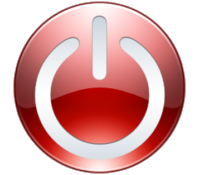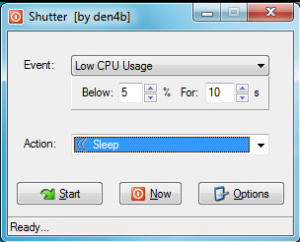 Shutting down your PC is often simple and straightforward. You finish what you’re doing, save your work, close any applications and hit the shutdown button: done.
Shutting down your PC is often simple and straightforward. You finish what you’re doing, save your work, close any applications and hit the shutdown button: done.
Sometimes, though, life is more complicated. Maybe you want to leave your PC running and have it automatically close at a particular time, say; when a program has finished running, or on some similar event. And that can be more difficult to organize -- unless you get a little help from Shutter.
This compact tool comes in a tiny 430KB download, and there’s no installation required, no adware or any other concerns: just unzip it and you’re ready to go.
 And, while there’s no local help, the straightforward interface means you’re unlikely to have any major questions about its core functionality. Take the default "Countdown" event, for instance: all you have to do is set a timer to 5 minutes, 1 hour or whatever, choose the action you’d like performed at the end of that time (Shutdown, Sleep, Hibernate, Logoff and so on), and click Start. Shutter will begin the countdown and carry out your chosen action after the defined time.
And, while there’s no local help, the straightforward interface means you’re unlikely to have any major questions about its core functionality. Take the default "Countdown" event, for instance: all you have to do is set a timer to 5 minutes, 1 hour or whatever, choose the action you’d like performed at the end of that time (Shutdown, Sleep, Hibernate, Logoff and so on), and click Start. Shutter will begin the countdown and carry out your chosen action after the defined time.
Countdowns are just the start, though. You can also tell Shutter to activate at a specific time; if your CPU usage drops below a certain level; if your battery is low; when a user is inactive; when a window closes, or a process stops; when a ping is no longer returned, when a file exceeds a given size, and more.
Despite its name, Shutter isn’t just about shutting down. You can alternatively have the program sleep or hibernate your system, turn off your monitor, mute or unmute the master volume, play an alarm, and more.
And the Options dialog reveals even more power. You can have the program run specific programs when the defined event occurs, for instance, play a sound, or close named windows. There are lots of ways to fine tune things, including the ability to restart an event when it’s been triggered. You even get a web interface to control the program remotely.
Yet all of this comes in a tiny program, requiring less than 1MB hard drive space and 3MB RAM, which is entirely free for personal use.
If we go looking for problems, then the fact that there have been no updates since 2010 might be a minor issue. There’s also no local documentation, and the online help isn’t particularly good (although you won’t need it very often).
For the most part, though, Shutter is a very capable shutdown tool with a great deal of features and options, and it’s well worth a closer look.

